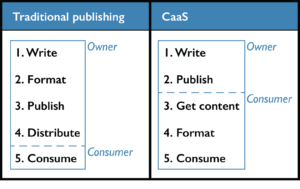CaaS makes it easier to deliver custom content
To provide the best customer experience, you need customized content that goes beyond what “traditional” publishing can do. Content as a Service (CaaS) offers a solution for complex content delivery requirements.
What is CaaS?
CaaS is a content management approach that makes it easier to deliver customized content to your consumers on demand. To do this, CaaS reverses the traditional publishing process.
Traditional publishing vs. CaaS publishing
Typically, content creators package and publish content for consumers. With CaaS, consumers request the content they need before it’s been formatted and published. This means that ownership of tasks in the content lifecycle shifts from the content creator to the content consumer.
Traditional publishing vs. CaaS, created by Sarah O’Keefe.
The consumer requesting content may or may not be an individual. Often the consumer is a system such as a learning management system.
CaaS and your content repository
Before implementing CaaS, you’ll typically have a system like a component content management system (CCMS) or headless CMS. With these systems, there is one version of each component of your content. Your content components are stored in a format-agnostic repository, and they only need to be updated once for the change to be applied everywhere they are referenced. In addition to packaging components for traditional publishing, you can use a CaaS layer on top of these systems to query the repository for specific content chunks.
Our one-minute video walks you through this process!
Also, CaaS is helpful because it reduces the amount of content delivered to the target device. Rather than pushing large amounts of general content, CaaS allows the systems consuming content to pull exactly what they need.
For a deep dive into how CaaS works, read this article by Sarah O’Keefe. If you want to see CaaS demos, you can also check out our 1-hour webinar.
“The number one takeaway from this presentation, other than, ‘Hey, those are cool demos!’ is the concept that Content as a Service is going to reverse your traditional publishing workflow.”
— Sarah O’Keefe
Flexibility
The core benefit of CaaS is the flexibility it provides for you and your consumers. Consumers can choose the content they need when they need it. Your content authors can easily create and edit content so that your consumers are pulling updated information.
Scalability
By introducing this flexibility, your content operations become scalable. As your content requirements and opportunities grow, such as product expansion and localizing content for new regions, CaaS can expand accordingly.
CaaS requirements
If CaaS sounds like the right step for you, that’s great! However, you need to be sure your organization completes these milestones as you move forward.
- Identify your content needs: Understand what your content requirements and goals are. This will guide you in choosing the right tools.
- Find a CMS, CCMS, or headless CMS: Choose a platform that aligns with your content needs. As content strategists, we rely on our decades of experience to advise you on choosing a system. To avoid conflicts of interests, we do not resell software or accept referral fees from software vendors.
- Delivery requirements: Once you’ve chosen a content management system, you need to connect it to your delivery outputs.
- Training: Once you’ve integrated CaaS in your content operations, it’s imperative that you give your team training.
We recommend bringing in an enterprise content strategist (like Scriptorium!) to help you through this process. By implementing CaaS effectively, you can future-proof your content operations and ensure your organization provides the best user experience.
More questions about CaaS? Let’s connect!
"*" indicates required fields






